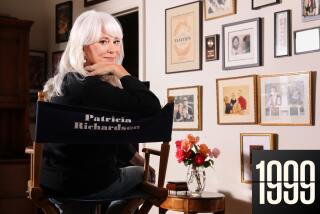Alice, all grown up: Barbara Hannigan on singing in a new Wonderland
The Canadian soprano and conductor Barbara Hannigan has been referred to as “a Hitchcock blond” and “a Bond girl,” but one never knows in what guise she might turn up. She’s embodied Alban Berg’s Lulu and powerfully channeled the leads in contemporary masterpieces like George Benjamin’s “Written on Skin” and Hans Abrahamsen’s “let me tell you.”
Hannigan recently arrived in Los Angeles after her first visit to Ojai. She’s planning ahead for her stint as music director of the Ojai Music Festival in 2019. From there, Hannigan went into rehearsals with conductor Thomas Adès and the L.A. Phil New Music Group for the world premiere at Walt Disney Concert Hall on Tuesday night of Gerald Barry’s opera, “Alice’s Adventures Under Ground.”
SIGN UP for the free Essential Arts & Culture newsletter »
The Irish composer’s 70-minute “Alice” features six other singers in multiple roles, including mezzo Allison Cook as the Queen of Hearts and the Mock Turtle, among other figures, from Lewis Carroll’s “Alice’s Adventures in Wonderland.” (Barry chose to use the book’s original title.) But the spotlight is largely on Hannigan’s provocative Alice. In this edited conversation, Hannigan spoke about her portrayal of Alice as an adult, Barry’s signature outrageous style, and what her role as Ojai’s music director might be like.
Is living in composer-librettist Gerald Barry’s world a bit like Lewis Carroll times 10?
Yeah. That’s a good way to put it. This is the fourth collaboration I’ve had with Gerald, and I know what I’m in for and yet it never gets easier. I mean that in a good way. It’s always challenging. I feel like I have to be gymnast Simone Biles in a 45-year-old body.
For a lot of people, it feels like America’s fallen down a rabbit hole. Is Barry’s “Alice” perfectly timed?
We certainly need to laugh. And I would be surprised if we don’t get some laughs in this show. In hard times, humor is a healing force.
Is Alice frozen in our imaginations as a little-girl caricature?
The original Lewis Carroll character was a real little girl who didn’t always behave. She was reacting, angry or fed up with things, which I like very much. And then Disney got hold of her and she became this [she sings sweetly] “Al-ice in Won-der-land”-kind of caricature and a lot prettier. Everything got smoothed over. I’m trying to give Alice a bit of a subversive quality. I chose an outfit that’s close to the character I’m trying to bring out in her. It’s definitely not Disney. My Alice isn’t trying to please anybody. She’s trying to figure out what’s going on and where she is. Just like all of us.
So this is an “Alice” for adults only?
I’m not pretending I’m a 10-year-old girl. I am myself, at my age, with my experience and perspective, playing Alice. And that for me is interesting — to come at her from a life perspective. She doesn’t have the innocence of a young girl. It’s something else.
How does Barry’s music convey Carroll’s famously topsy-turvy world?
Gerald’s music always pushes beyond extremes. The speeds and relentless quality of his music are extraordinary. He doesn’t compromise. He likes to repeat things, so the Jabberwocky appears a lot in various languages. When Gerald likes something, he keeps doing it until you can’t stand it anymore. But it’s a bit like Quentin Tarantino, where scenes of violence became comic. It’s like that with Gerald’s music. There’s a quality of absurdity present.
What should we listen for in “Alice”?
Well, you’ll get a lot of C major and G major. Gerald’s music is immediate and visceral. His construction is brilliant, but it’s not heady stuff. There are many familiar pieces hidden within the score. I don’t want to give away the jokes, but there’s a bit of “Moonlight” Sonata, some Irish folk tunes, and some of Carl Czerny’s piano studies. I have to sing a lot of technically demanding lines, different kinds of arpeggios and scales. There’s a whole section about the art of playing the piano, but it’s so frenetic — a competition that puts all of the singers on the edge of their game.
It’s early, but what can you tell us about your plans as music director at Ojai for 2019?
I’m getting a feel for the place, checking out its spaces and looking at possibilities. I did a small event for the community, sang a bit and did an interview with [artistic director] Tom Morris. I’m super-excited and already have a lot of plans. It’s unlikely it will be all contemporary music. If you look at my programming as a conductor, I never do exclusively contemporary programs. I like to mix it up.
How do you sing and conduct at the same time?
It’s so funny, because all these pianists and violinists play and conduct. But singers are the only ones who have their hands free. You would think that would be the most natural thing. When I slow down in the singing, the conducting will take a lot more space.
George Benjamin wrote “Written on Skin” for you. How long will you sing the role of Agnes?
I’ll sing it for the last time at Covent Garden in January. I’ve sung it over 30 times. The piece has had a great response, a great life. It doesn’t need me. Other sopranos are going to have huge success with it.
How do you track the emotional geography of new music. Isn’t some new music meant to be distant, even cool?
There’s emotion even in distance and coolness. Few people take an analytical approach, even to Boulez. They’re affected by sound color, discipline, the act of live performance. The actual production of sound is so emotional. That’s why vocal music, especially contemporary vocal music, is more direct than purely instrumental music. There’s the challenge of the instrument being inside one’s body.
You’ve performed about 85 premieres to date. Why didn’t you go the standard coloratura route?
Because I would have been bored to tears. One of the first roles I sang was Mozart’s Queen of the Night from “The Magic Flute.” I’m happy I sang it, but I never wanted to sing it again. It’s just not me. I like complicated music, and I’m passionate about working with composers in our time.
Follow The Times’ arts team @culturemonster.
ALSO
Baryshnikov captures Nijinsky’s madness in near-perfect ‘Letter to a Man’
St. Petersburg’s Mikhailovsky Ballet revises the pirate-tale classic ‘Le Corsaire’
Let the power of ‘Hamilton’ speak louder than a Twitter feud
More to Read
The biggest entertainment stories
Get our big stories about Hollywood, film, television, music, arts, culture and more right in your inbox as soon as they publish.
You may occasionally receive promotional content from the Los Angeles Times.










